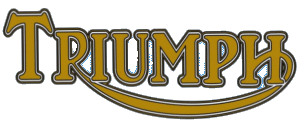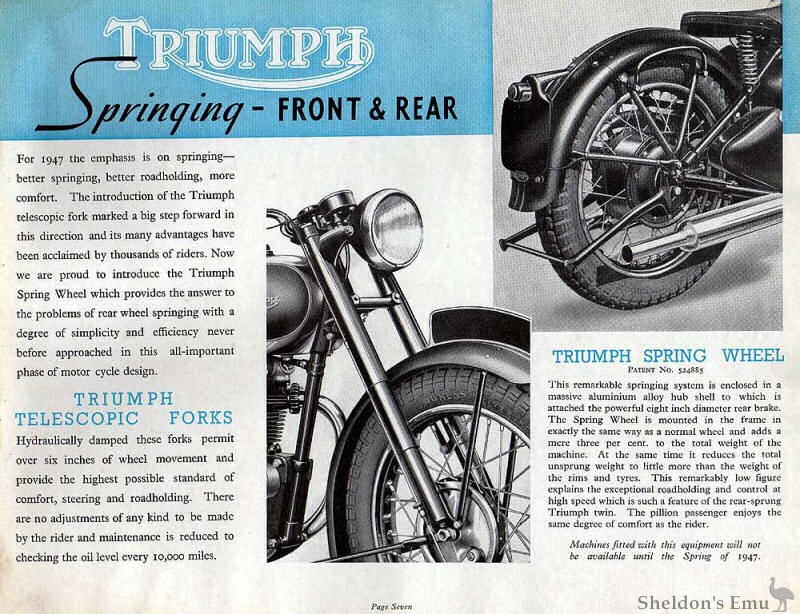



TRIUMPH SPRING WHEEL
PATENT No. 524889
This remarkable springing system is enclosed in a massive aluminium alloy hub shell to which is attached the powerful eight inch diameter rear brake, The Spring Wheel is mounted in the frame in exactly the same way as a normal wheel and adds a mere three per cent. to the total weight of the machine. At the same time it reduces the total unsprung weight to little more than the weight of the rims and tyres. This remarkably low figure explains the exceptional roadholding and control at high speed which is such a feature of the rear-sprung Triumph twin.
The pillion passenger enjoys the same degree of comfort as the rider. Machines fitted with this equipment will not be available until the Spring of 1947.
by A.H.
The sprung hub was a stop gap measure between the pre war rigid frame and the post was swinging arm designs, it sacrificed the rigidity of the former without offering the hydraulic damping of the latter.
Taking a sprung hub apart endangers both life and limb and having a personal physio on hand is advisable but not listed in the maintenance manual.
Edward Turner claimed the idea was his own, believed that for effective rear springing, it wasn't the amount of wheel travel that was important, but the characteristics of the movement. Therefore the small amount of travel of the sprung hub (2") would not be a disadvantage.
Originally laying the design out on paper in 1938, Turner was looking for rear springing that added little weight and complexity and with little additional cost. And although he didn't say so, any design that left the sleek lines of the Speed Twin intact where likely to find favour.
Due to the war, the first appearance of the sprung hub was on Ernie Lyons 1946 Senior Manx winning GP machine [1], but by then the goal posts had been moved, With the ravages of war, with little money whilst their european competitors the Germans and Italians who had instigated that war and had their asses kicked where now benefiting from having their houses and factories rebuilt and new machine tooling installed with the aid of US dollars (Marshall Aid), they also had their war debts wiped clean whilst we are still paying.
Against this climate, Triumph couldn't keep pace with the production of existing models let alone contemplate an all new range, what was there in 39 had to suffice. Now the advantages of the sprung hub where very different, existing rigid frames would adapt to it, new suspension could be added as an optional extra and existing owners could buy it and bolt it straight in, therefore hard pressed production facilities where not disrupted. Triumph had moved the speedo drive from the front wheel to the back and now with the adoption of the hub moved it yet again to its final resting place, the gearbox.
Now in all fairness to the design, and I ride both the earlier rigid and the later swinging arm machines, the advantage of the sprung hub over the rigid is that you do not lose traction over bumps when you've got it tramping along, at least the rubber stays in contact with the tarmac, and in reality it is hardly worse than the Ton Ten which really points to something else being flawed.
The forks look nice but they are flimsy and do more easily what all telescopics do -FLEX, the frame is a single down tune that connects to the double cradle under the engine with a bolt, anything bolted will work loose eventually and it might have been better had they used an all welded design, then there's the head angle, and all this had to wait until after Turner himself had gone. He designed for aesthetic beauty first and foremost - and he didn't get that bit wrong - the rest you learned to live with, trouble is that a short time after the war had ended 2 really good frames became available that effectively made Triumphs look as though Noah had chucked it overboard from the Ark, BSA's duplex and the legendary Featherbed.
Back then all this was ok, the motorcyclists of the day had grown up with rigid frames, the cheaper and easier to fix the better, blokes who rode then had no other means of transport, and then the scene changed dramatically in 1958. The government of the day relaxed the rather draconian laws regarding that evil - money lending - loan sharking - call it what you will, now they call it credit and positively bombard you with junk mail to have some.
The effect of this change was that a mere school leaver could IF his legal guardian signed as guarantor go out and buy what was then the worlds fastest production sporting roadster and GO. Within a short period of time this caused the government to comment that road casualties where akin to a war zone and that things had better change or else. This wasn't confined to inexperienced bikers either, and they took no notice so we got speed limits, seat belts and crash helmets legislated in to keep us safe and of course handling had to improve or there'd be no one left to ride.
The one thing however sprung hub riders got that went for good at its demise was the luxury of a super powerful 8" rear brake, breath on that and the back end is around your ears pdq.
At its launch for production models for the 1947 range the hub cost a whopping stlg20..5s..6d or 10% of the cost of the Tiger 100, that was a lot of money back then, but brought in much needed capital, I would guess that on a race track with a smooth surface few of the faults you encounter on normal roads would show up, the press reports I have dug out from back then positively glow with admiration for it (they tell even bigger whoppers nowadays) and one stated that Ernie Lyons GP win was down to the use of this sprung hub, more likely it was down to the atrocious weather conditions and Ernie's bravery.
Alex Scobie, a Triumph experimental shop tester raced a GP model with the hub under a pseudonym and he says he experienced serious wallowing on bumpy corners, he later discovered that fellow GP rider Bob Foster had lowered his tyre pressures to almost 'off road' levels to counteract this effect, you begin to realize just how good we have it these days. My plan to go vintage racing with the 100C will be modified to fit a standard rear wheel rather than risk the hub's idiosyncrasies at speed, unlike Ernie, Alex and I don't have the bottle.
For my next instalment on the wonders of Triumph ownership I shall render for you the nit-wits guide to timing them; well I can do it so for you it should be a piece of cake.
Alison
Attribution unknown. Posted by Sheldon pre-2004. Ed.
1. Triumph GP with Sprung Hub, 1949